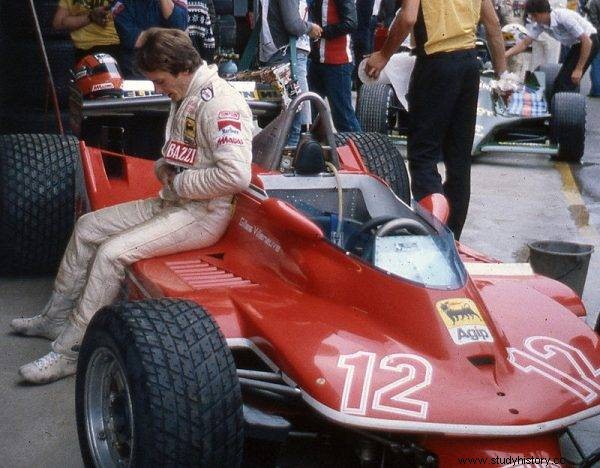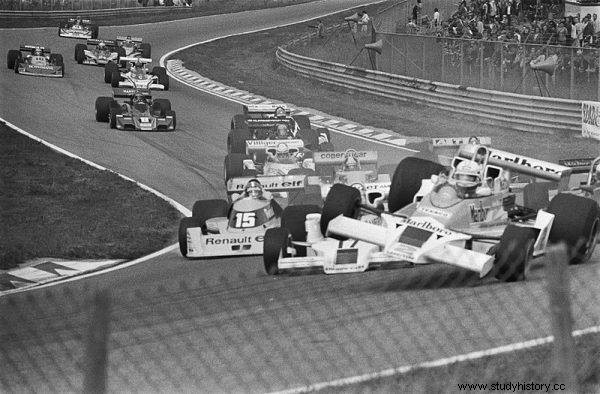A thin line - that's all between madness and courage. It is extremely easy to break it. The 1980s in Formula 1 saw the debuts of Alain Prost and Ayrton Senna. It is the "turbo era" in which the pursuit of victory, power and money has increased the spectacle of racing. The number of accidents, including fatal ones, has also increased.
In the 1970s, Formula 1 was a field of competition for British designers who focused on aerodynamic solutions and the Italians from Ferrari, who were infatuated with power. The battle was in full swing and the competitors focused on themselves did not notice that there was a breakthrough behind them.
In 1977, a new player entered the field, the French Renault with their RS01. The car went down in history as the first Formula 1 machine to use a turbocharged engine.
Initially, the competition did not pay attention to the bizarre solution of the French, because they simply did not succeed. Their cars were unreliable and failing, and in the 1977 and 1978 seasons the team focused on work and experience. The breakthrough came in 1979 with the French Grand Prix at Dijon, where Renault driver Jean-Pierre Jabouille won and his teammate René Arnoux was third. This fact could not be ignored by the rest of the F1 teams.
What was this "turbo" about? The French took advantage of the loophole in the regulations and installed engines in their cars that generated great power with the help of a turbocharger with the help of a turbocharger. Much larger than previously used naturally aspirated units. It is true that they still had breakdowns, but more and more people worked on their removal from month to month.
Formula 1 has been joined by large car concerns, and with them huge money and modern technology. The "arms race" has begun. The Queen of Motosport thus entered a crazy period in which the propulsion units sometimes reached the power of 800-900 KM. They also exploded frequently, making them known as "grenade engines".
A large group of drivers driving the cars did not have the skills to tame these beasts. In addition, there were tracks, the outdated structures of which were not prepared for such a speed. It was not difficult to find accidents. Unfortunately, also deadly.
Gilles Villeneuve - a spectacular favorite
On May 8, 1982, the final qualifying session for the Belgian Grand Prix ended at Zolder. A red Ferrari driven by Gilles Villeneuve crashed into the rear of Jochen Mass's slower car and shot into the air. The impact was so strong that the torn car flew several dozen meters.
The Canadian fell out of the cockpit, his limp body only stopping at the fence. The medical services immediately arrived at the scene. Villeneuve was not breathing, but his pulse was palpable. CPR has started . He was transported to hospital, where he died a few hours later. In the post-accident investigation it was found that he, the driver, was to blame.

Gilles Villeneuve with his Ferrari in 1979.
Gilles Villeneuve's premature death caused a wave of sadness among the fans and people associated with Formula One. Enzo Ferrari, the legendary Italian constructor and his boss at the time, suffered a great deal. It was an open secret that he always treated the driver like a son, took care of him and supported him in difficult moments.
For fans of the Queen of Motorsport, the departure of Villeneuve was associated with the end of an era. The Canadian from 1977 delighted them with an uncompromising driving style. Where others slowed down, he pressed the accelerator harder; he loved risk and competition . And people liked it. But who knows, whether the incessant drive to defeat his opponents implanted in him was not the indirect cause of his death?
Two weeks before the flawed Belgian Grand Prix, Gilles vowed never to speak to team partner Didier Pironi again. What was it about? During the San Marino Grand Prix, on the Imola circuit, the Canadian was the leader of the race until the last lap. The Italian stable bosses ordered their drivers to slow down and hold their positions. Villeneuve, believing he would probably win, obeyed. Pironi broke the agreement, overtaking his team-mate in the final parts and winning.
For Gilles, it was a slander and an insult for which Didier had to pay. The Canadian decided not to talk to him anymore and to prove that he is a better driver each time. Perhaps at Zolder it was this tension and the will to beat his teammate that made Villeneuve take too much of a risk. A risk with his life.
Riccardo Paletti - 28 minutes on fire
Just over a month after the events in Belgium, the drivers started the Canadian Grand Prix. It was a difficult moment for Didier Pironi. He, who had a hard time on Canadians, was to race in Montreal, the city still mourning Gilles.
After the events on the Zolder track, some of the environment began to treat him cooler. People remembered him Imoa and his gentlemanly behavior . Pironi saw it, but while there was a change in his behavior behind the scenes, he remained himself on the track. A good old Didier who loved speed and competition. In Montreal he won pole position and was ready to win the whole race.
On June 13, 1982, the French set his Ferrari at the start. He waited for a green light to appear on the beacon. Seconds passed and suddenly the car engine stopped. Pironi tried to fire it but failed. He raised his hand to signal the problem. At this point, a green light came on. The other drivers started moving and he was standing still.

An accident at the 1977 Danish Grand Prix.
More cars passed the damaged car. When it seemed that the situation could be brought under control, a tragedy ensued. Riccardo Paletti, driving for the Osella-Ford team, crashed into Pironi's car at a speed of nearly 200 km / h.
A group of people who wanted to get the stuck and unconscious Italian out of it immediately appeared next to the destroyed car. Doctor Sid Watkins first tried to measure the driver's pulse. He walked towards him. Suddenly the gasoline spilled from the tank caught fire. The car is on fire . The fire extinguishers went in motion. The fire was only contained after 28 minutes.
Riccardo Paletti was hospitalized, where he was pronounced dead. It turned out that the injuries after the accident were so great that - according to the doctors - the driver died right after the impact. The fire had no effect on his death. Most sadly, however, is the fact that he was dying in front of his mother. The woman and her son came to Canada because the family was going to celebrate his 24th birthday two days after the race. When Riccardo was dying, she was sitting in the stands. She saw everything.
Paletti was a rookie. He made his Formula One debut a few weeks earlier, but as soon as he entered the paddock, he aroused interest. The young man was often accompanied by a doctor who monitored his health on an ongoing basis. In addition, Riccardo adhered to a specially created diet. In the 1980s, such a professional approach was just beginning to develop. Not every driver understood them.
Testing and the end of the race
Villeneuve and Paletti lost their lives racing. Patrick Depailler and Elio de Angelis died during the tests. The case of the latter was so tragic that the Italian could be saved.
In May 1986, during testing on the Paul Ricard circuit in France, the rear wing of the BT55 de Angelis broke off. The car went off the road and started to burn. 29 hours after the accident, the Italian competitor died. His death was not due to an impact. Elio had a broken collarbone and minor burns on his back. However, he could not get out of the car on his own, which made him inhale smoke for several minutes. If the rescue had gone more smoothly, the multi-talented Elio might have survived.
After this tragedy, the rules were changed. Medical services and a helicopter were also required during the tests. The FIA took turbo engines seriously, and in 1989 completely banned their use. According to various sources, there were 540 accidents during races in the 1980s.
The "turbo era" with all this madness, power and construction war has brought some positive changes. In the end, the medical security of the competition was taken care of, safety cages appeared in the cars, the cars had to pass crash test front part. The real revolution took place at the turn of April and May 1994 - after the "black weekend in San Marino", in which, among others, was killed. the legendary Ayrton Senna. It was then realized that the show should never obscure common sense.
